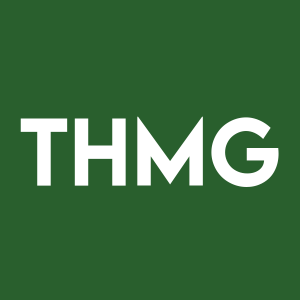Thunder Mountain Gold Reports on Newly Acquired Historical I.P. and Airborne Geophysical Data at the South Mountain Project, Idaho
Rhea-AI Summary
Thunder Mountain Gold (OTCQB: THMG) (TSXV: THM) reports on newly acquired historical IP and airborne geophysical data at the South Mountain Project in Idaho. The data supports a conceptual model suggesting a copper-molybdenum porphyry system beneath or adjacent to high-grade zinc, silver, copper, and gold mineralization. Highlights include:
1. District-scale aeromagnetic and deep-penetrating IP survey data from the 1970s
2. Geochemical survey data from 2,300 rock chip and 850 soil samples
3. High copper geochemical assays exceeding 1,000 ppm
4. IP anomalies trending deep beneath known mineralization
5. Historical drill data showing a 500-foot thick interval exceeding 100 ppm molybdenum
The company plans further exploration, including extending IP lines and adding Magnetotelluric coverage to investigate deeper into the system.
Positive
- Acquisition of historical geophysical and geochemical data supports the potential for a large copper-molybdenum porphyry system
- High copper geochemical assays exceeding 1,000 ppm in and around known polymetallic CRD mineralization
- Historical drill data shows a 500-foot thick interval exceeding 100 ppm molybdenum, indicating significant mineralization potential
- Planned multi-faceted exploration program for 2024-2025 to further investigate and expand the resource potential
Negative
- Exploration plans are contingent upon financing, which may delay or limit the scope of the program
- Historical data from the 1970s may not fully represent current geological conditions
News Market Reaction 1 Alert
On the day this news was published, THMG declined 12.60%, reflecting a significant negative market reaction.
Data tracked by StockTitan Argus on the day of publication.
Remodeled data and historical reports pave the way for expanding the alteration footprint, and further defining the extensions to existing CRD (Carbonate Replacement Deposit of silver, zinc, gold, and copper) resources and the potential of copper and molybdenum porphyries.
Highlights:
- Newly-acquired district scale aeromagnetic and focused / deep penetrating IP survey data conducted by Phoenix Geophysics and Dr. Phil Hallof (Canadian Mining Hall of Fame), and Scintrex Geophysical Survey in the 1970s.
- Geochemical survey data and interpretations from 2,300 rock chip, and 850 soil samples conducted previously by Austral Oil (1970).
- High yielding copper geochemical assays in and around the known polymetallic CRD mineralization, with historic assays exceeding 1,000 ppm, and
- Polarization and resistivity anomalies, trending deep beneath and adjacent to the known polymetallic CRD mineralization, and
- Récent acquired historical drill data, including a 500-foot thick interval exceeding 100 ppm molybdenum in hole DDH 5-5 - adjacent to the Texas Mineralized Zone, along with anomalous copper intervals.
Boise, Idaho--(Newsfile Corp. - September 17, 2024) - Thunder Mountain Gold, Inc. (OTCQB: THMG) (TSXV: THM), (the "Company" or "THMG") is pleased to report recently acquired induced polarization ("IP") and airborne magnetic geophysical survey data, along with a copper in soils geochemical survey ("Geochem") at the South Mountain Project ("South Mountain" or "South Mountain Project" or the "Property") in southwestern Idaho, U.S.A.
This newly acquired IP and geochemical data supports the conceptual model that suggests that the system responsible for the high-grade zinc, silver, copper, and gold mineralization in the carbonate units is driven by a copper - molybdenum porphyry beneath or adjacent to the high-grade mineralized zones. 2,300 rock chip and outcrop samples were analyzed, along with 850 soil samples from a grid covering the suspected porphyry.
With this data, the Company has also discovered that a diamond drill hole drilled by Austral Oil in the 1970s returned 500 feet of continuous anomalous molybdenum.
Figure 1. Location of South Mountain Project
To view an enhanced version of this graphic, please visit:
https://images.newsfilecorp.com/files/8664/223570_fefbd83d4483b883_001full.jpg
"We're excited to advance our exploration efforts with this IP, Aeromagnetic, and Geochem data, exposing new targets into what could be a very large system," Eric T. Jones, President and CEO of the Company commented. "Recent review of the data suggests the potential of up to three copper and moly bearing porphyry intrusions, as suggested by Dr. Richard Sillitoe and others from previous visits to the property. We are now focused on expanding and testing these new anomalies, using confirmational Geochem and also extending the IP geophysical lines and adding Magnetotelluric (MT) coverage to look much deeper into the system. We are also looking at extending the down plunge polymetallic CRD and skarn zones that we have explored and developed underground."
Eric T. Jones added, "Oligocene felsic intrusive host rocks are big in Idaho as evidenced by Thompson Creek in central Idaho. However, our current model at South Mountain is more analogous towards the Battle Mountain Complex and the Phoenix Deposit in northern Nevada. It is still our belief that South Mountain has the potential to be one of the lowest cost producers of silver, gold and zinc in north America, and the possible porphyry copper - molybdenum association increases the excitement associated with these recently re-discovered exploration data sets."
DETAILED HIGHLIGHTS:
Historical Geochemical Data:
In 1970, Austral Oil Co. recovered 2,300 rock-chip outcrop samples from the South Mountain Mine area which were assayed for gold, silver, copper, lead, zinc, antimony, arsenic, mercury, molybdenum, and tungsten, with occasional assays of nickel, chrome and manganese. This data was entered digitally into the Austral Oil database and interpreted in their technical report on plates that are currently being reproduced by THMG.
850 soil samples in a grid were taken at South Mountain, some of which were sampled for copper, molybdenum, and mercury. These data are also recorded and displayed in the Austral Oil report. The results and findings of this work show "substantial geochemical anomalies which coincide very nicely with the geology at South Mountain". Some of the uniformly gridded samples resulted in assays in excess of 1,000 ppm copper anomalies, and molybdenum anomalies of over 500 ppm, also coinciding with an I.P. anomaly.
Several gossans were mapped at that time. These gossans are enriched with oxides derived from pyrite, sphalerite, chalcopyrite, with occasional anomalous assays in gold, silver, copper, lead and zinc.
Geophysical Data:
Regional and detailed Induced Polarization and Resistivity (IP) data acquired by Phoenix Geophysics in the late 1970's under the direction of Mr. John Reynolds, currently with Durango Geophysical Operations, and interpreted by Dr. Phil Hallof, President of Phoenix Geophysics, have been digitized and entered into current State-of-the Art 2-D & 3-D IP modeling and display technologies not available in the late 1970's. The deeper IP data show depth extensions to the existing delineated CRD / skarn mineralization extending beneath the current levels of exploration drilling. Shallow IP data identify several near surface possible mineralized CRD / skarn polarization responses that should be targeted and drill tested. Deeper IP data (~1,000 feet to ~1,500 feet depth of investigation) indicates at least one possible center for the source of these mineralizing fluids. Also discovered was an extensive and detailed Aeromag survey, and airborne Electromagnetic Survey ("EM"), both conducted by Austral Oil Company. These data sets significantly add to the exploration program and will be instrumental in the planning and execution for the upcoming field exploration operations during the remainder of 2024.
Figure 2: Cross Section from the Inversion Modeling looking northeast along strike of the Laxey Marble.
To view an enhanced version of this graphic, please visit:
https://images.newsfilecorp.com/files/8664/223570_fefbd83d4483b883_002full.jpg
Figure 3: Re-processed IP chargeability data at 450 meters true depth
To view an enhanced version of this graphic, please visit:
https://images.newsfilecorp.com/files/8664/223570_fefbd83d4483b883_003full.jpg
Historical Drilling:
Historical drill logs were recovered and analyzed from 8 angled core holes drilled in 1971 by 2 E.J. Longyear Company core rigs. The deepest hole was 1,996 feet, and all of the holes were chosen based upon the I.P. Survey results. The most notable intersection from the drilling was a 500-foot-thick interval exceeding 100 ppm molybdenum in hole DDH 5-5 - adjacent to the Texas Mineralized Zone, along with anomalous copper intervals.
Figure 4: South Mountain Project Geologic Model.
To view an enhanced version of this graphic, please visit:
https://images.newsfilecorp.com/files/8664/223570_fefbd83d4483b883_004full.jpg
Qualified Person(s) Statement for the Technical Data in this Release
The technical information in this news release has been reviewed and approved by Tyson Forbush, C.P.G., consulting Project Geologist with GeoTech LLC, and a "Qualified Person" as defined by the U.S. SK-1300 regulations, and Mr. Dale Moore, a consulting Geologist with Tamarack Geological Services, a "Qualified Person" as defined by U.S. Regulation SK-1300 and National Instrument 43-101 (Canada) standards. The 2-D Geophysical Modeling was completed by Durango Geophysical Operations and the 3-D visualization of these data sets was preformed by Mr. Dale Moore of Tamarack Geological Services using Leapfrog Geo® Software version 2023.2.1.
Planned Exploration and Development for South Mountain Project Area
THMG has a planned, multi-faceted exploration program for the remainder of 2024 and into 2025 at South Mountain. This Program consists of regional structural geologic studies, focused on porphyry copper-molybdenum geologic mapping and sampling, and an extension to the existing IP data set focusing on deeper investigation of the existing polymetallic CRD / skarn mineralization at South Mountain. Additionally, a Magnetotelluric (MT) exploration program is planned that will focus on locating the potential deep seated porphyry mineralization centers. These programs and their timelines are contingent upon financing.
In addition to Company Management, the THMG Advisory team consists of:
John Reynolds - Durango Geophysical Operations: John will over see the geophysical data acquisition and processing of the planned deeper IP data and the MT data acquisition program. John is credited with the geophysical based discovery of the Las Colinas/Los Planes ore deposit located in Baja California Sur (~1.6 million ounces Au) and the 2003 geophysical based discovery of the Boa Esperanca Copper Cobalt deposit in the Tucuma region of Para, Brazil.
Rich Leveille - Consulting Exploration Geologist- Rich will over-see the porphyry-focused copper-molybdenum geologic mapping and sampling. Rich has an impressive exploration track record including boots on the ground 1st recognition of the Penasquito ore deposit (VP Exploration for Kennecott), leading the discovery team for the Sossego-Sequeirinho IOGC deposits in the Carajas region of Para, Brazil (VP Exploration - South America for Phelps Dodge), and more recently Rich was Senior VP Exploration for Freeport-McMoRan. Rich and Team have added 54 billion tons of copper to reserves and is credited with the Chukarui Peki discovery in Serbia which earned Rich has a shared 2016 PDAC Thayer Lindsley International Mineral Discovery Award.
Dr. Stephen J. Reynolds - President's Professor, Emeritus, Arizona State University: Steve will oversee the structural geology aspects of the exploration program at South Mountain focused on expanding the existing known silver/gold/zinc/copper resources down dip and along strike and with regional porphyry copper-molybdenum exploration. Steve's successful exploration experience ranges from porphyry copper, precious metals, and rare-element resources throughout the western U.S. and Mexico. Steve is credited with recognizing and changing the exploration model for the southern Baja California disseminated gold-bearing systems of Paredones Amarillos and Las Colinas by recognizing that the gold-bearing fluids were the result of late stage, near vertical, brittle structures, a reinterpretation that went against the existing geologic model that had been mistakenly followed for over 12 years.
Dale Moore - Tamarack Geological Services: Dale provides integral geological, geochemical, and geophysical modeling support via the Leapfrog program to aid in the 3-D definition of potential deeper resources. Dale has been credited with being an integral part of the Americas Gold and Silver Galena GIP exploration program that added over 100 million silver equivalent ounces to the Galena Resources.
Karen Christopherson - Chinook Geoconsulting - Karen will focus on the interpretation of the geophysical data sets, in particular the Magnetotelluric (MT) data which will aid in the identification of potential deep-seated porphyry copper-molybdenum mineralized systems utilizing State-of-the-Art MT data processing algorithms and 2-D / 3-D computer modeling and interpretation programs.
The South Mountain Project
The South Mountain Mine is a polymetallic development project containing high-grade zinc, silver, gold, and copper, and is located on private land approximately 70 miles southwest of Boise, Idaho (See Figure 1 above). The Project is on private land, permitting has been, and should continue to be a clear-cut process. The Project was intermittently mined from the late from 1940s to the late 1960s, most notably by Anaconda Mining, with over 4,000 feet of underground developmental workings that that have been rehabilitated, re-engineered, and MSHA compliant. Thunder Mountain Gold Inc. purchased and advanced the project from 2007 through Present, with expenditures into the project of approximately US
Regarding Thunder Mountain Gold, Inc.
Thunder Mountain Gold Inc., a junior exploration company founded in 1935, owns interests in base and precious metals projects in the western U.S. The Company's principal asset is The South Mountain Mine, a historic former Anaconda Mining development of zinc, silver, gold, lead, and copper, located on private land in Owyhee County Idaho. Thunder Mountain Gold also owns
OTHER COMPANY NEWS:
The Company has reserved December 10, 2024, for its annual shareholder meeting. Further details will be distributed to shareholders in the upcoming Proxy Statement.
Forward-Looking Statements
This press release contains forward-looking statements that are based on the beliefs of management and reflect the Company's current expectations. Generally, forward-looking statements can be identified by the use of forward-looking terminology such as "plans", "expects", "is expected", "budget", "scheduled", "estimates", "forecasts", "intends", "anticipates", "believes" or variations of such words and phrases or statements that certain actions, events or results "may", "could", "would", "might" or "will be taken", "occur" or "be achieved" or the negative connotation thereof. The forward-looking statements are based on certain assumptions which could change materially in the future. By their nature, forward-looking information involves known and unknown risks, uncertainties and other factors that may cause actual results, performance or achievements to be materially different from any future results, performance or achievements expressed or implied by the forward-looking information. Investors should refer to THMG's Form 10-K, Form 10-Q reports, for a more detailed discussion of risks that may impact future results. There can be no assurance that forward-looking information will prove to be accurate, as actual results and future events could differ materially from those anticipated in such statements. Accordingly, investors should not place undue reliance on forward-looking information. Forward-looking information is provided as of the date of this press release, and the Company assumes no obligation to update or revise them to reflect new events or circumstances, except as required in accordance with applicable laws.
Cautionary Note to Investors
This news release is intended for release in the United States only. Neither the TSX Venture Exchange, the OTCQB, nor either of its Regulation Services Provider (as that term is defined in policies of the TSX Venture Exchange) accepts responsibility for the adequacy or accuracy of this release.
For further information, please contact:
Thunder Mountain Gold, Inc.
Eric T. Jones
President and Chief Executive Officer
Eric@thundermountaingold.com
Office: (208) 658-1037

To view the source version of this press release, please visit https://www.newsfilecorp.com/release/223570











